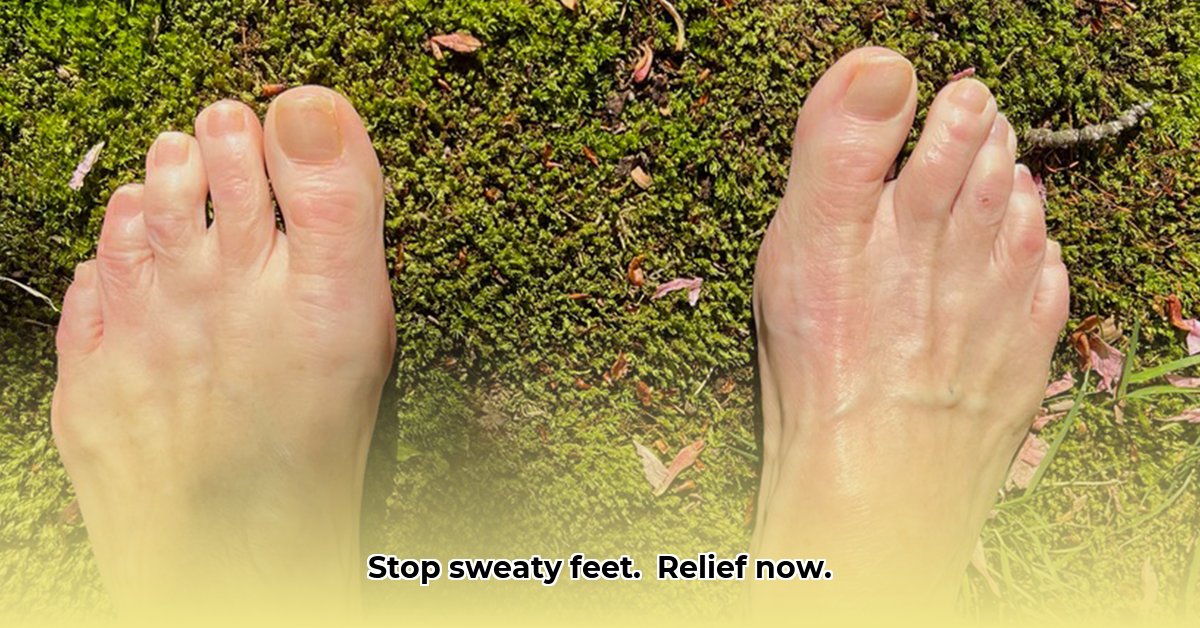Do your feet feel both freezing and soaked? You’re not alone. This uncomfortable condition is surprisingly common and could signal a deeper issue. Let’s investigate the causes of clammy feet, from simple at-home solutions to situations requiring medical intervention. We’ll explore self-care, proper foot hygiene, impactful lifestyle adjustments, and current medical treatments.
Decoding the Chilly, Damp Mystery: What Causes Cold, Sweaty Feet?
Cold, sweaty feet aren’t just an oddity; they often indicate an underlying issue disrupting the normal regulation of foot temperature and moisture. Understanding the physiological puzzle is the first step toward finding relief.
Understanding the Root Causes: Potential Underlying Conditions
Several conditions can lead to this frustrating situation, affecting blood flow, nerve function, or sweat production. Pinpointing the root cause is essential for effective management.
- Hyperhidrosis: Overactive Sweat Glands: This condition causes excessive sweating, often affecting the hands, feet, and armpits. Primary hyperhidrosis is often genetic, while secondary hyperhidrosis can be linked to underlying medical conditions or medications. Experiencing excessive sweating on your palms alongside cold, sweaty feet often points to hyperhidrosis.
- Raynaud’s Phenomenon: Blood Flow Disruptions: Raynaud’s affects blood flow to the extremities, particularly fingers and toes. Exposure to cold or stress can trigger episodes where digits turn white or blue, feel numb or tingly, and may even sweat as blood flow returns. The Mayo Clinic notes that Raynaud’s can be primary (occurring on its own) or secondary (associated with other conditions like lupus).
- Hypothyroidism: Underactive Thyroid Gland: A sluggish thyroid disrupts numerous bodily processes, including temperature regulation. Feeling consistently cold despite sweaty feet can be a key indicator. Research published in Thyroid journal suggests that even subclinical hypothyroidism can impact thermal regulation capabilities.
- Peripheral Arterial Disease (PAD): Narrowed Arteries: PAD involves narrowed arteries, impeding blood flow to the limbs. Feet and legs often feel cold, with increased sweating potentially occurring as the body attempts to compensate for poor circulation. Symptoms may also include leg pain during exercise.
- Peripheral Neuropathy: Nerve Damage: Frequently linked to diabetes, trauma, infections, or autoimmune diseases, nerve damage can disrupt the body’s temperature regulation. Damaged nerves can send mixed signals, leading to the sensation of cold, sweaty feet. According to the National Institute of Neurological Disorders and Stroke, symptoms vary based on the type of nerve damage and can also include numbness, tingling, and pain.
- Anxiety: Anxiety triggers the body’s “fight or flight” response, which can lead to increased sweating and decreased blood flow to the extremities, resulting in cold, sweaty feet.
- Menopause: Hormonal fluctuations during menopause can disrupt temperature regulation, leading to hot flashes and cold, sweaty feet.
When To Seek Professional Help: The Doctor’s Evaluation
Don’t ignore persistent cold and sweaty feet. A doctor’s evaluation is crucial for identifying the underlying cause and preventing potential complications. Consult a healthcare professional if:
- Home remedies are ineffective: If self-care strategies fail to provide relief, seek professional guidance.
- Pain or unusual sensations are present: Report any intense pain in the feet, legs, or arms, as well as numbness, tingling, or unusual skin color changes.
- Other health changes occur: Consider overall health changes when evaluating your condition for a more holistic view.
- Excessive sweating is disruptive: If excessive sweating interferes with daily activities, seek medical advice.
- Sudden or worsening symptoms develop: Rapid onset or significant worsening of cold and sweaty feet warrants immediate medical attention.
A comprehensive checkup, including a review of your medical history and blood tests, will help identify the underlying cause. Your doctor may also perform a neurological exam or vascular studies to assess nerve and blood vessel function.
Your Personal Action Plan: Self-Care Strategies for Relief
Before seeking medical intervention, implementing self-care strategies can provide significant relief and improve foot health.
1. Foot Hygiene: The Foundation
- Step 1: Wash your feet daily with mild, antibacterial soap to remove dirt, bacteria, and excess sweat.
- Step 2: Thoroughly dry between your toes after washing to prevent fungal infections.
- Step 3: Apply a non-comedogenic moisturizer to keep your feet soft and hydrated, preventing dry, cracked skin. Consider a foot cream containing urea or lactic acid for added hydration.
2. Lifestyle Changes: Small Tweaks, Big Impacts
- Exercise: Regular physical activity improves circulation, aiding in better temperature regulation. Aim for at least 30 minutes of moderate-intensity exercise most days of the week.
- Diet: A healthy, balanced diet supports overall well-being and positively influences temperature regulation. Focus on whole foods, lean protein, and plenty of fruits and vegetables. The American Heart Association recommends a diet low in saturated and trans fats to promote good circulation.
- Stress Management: High stress levels can disrupt various body systems and influence sweating patterns. Practice relaxation techniques like yoga, meditation, or deep breathing exercises to manage stress.
- Footwear: Wear breathable socks made of natural fibers like cotton, merino wool, or bamboo to wick away moisture. Choose shoes that fit well and allow your feet to breathe. Avoid tight-fitting footwear that restricts blood flow.
- Smoking Cessation: Smoking damages blood vessels and impairs circulation, exacerbating cold feet. Quitting smoking can significantly improve circulation and reduce symptoms.
3. Over-the-Counter Helpers: Easing Symptoms
- Antiperspirants: Apply over-the-counter antiperspirants containing aluminum chloride to your feet, especially between the toes, to reduce sweating.
- Foot powders: Use absorbent foot powders containing ingredients like cornstarch or talc to keep your feet dry and comfortable.
- Orthotics: Consider using orthotic inserts to improve foot alignment and support, potentially improving circulation.
Always read and follow product instructions carefully. Consult your doctor with any concerns.
Medical Interventions: Options for Persistent Symptoms
If self-care strategies prove insufficient, your doctor may recommend more advanced treatments. Pursue these options under professional guidance.
| Treatment Option | Description | Potential Benefits | Considerations |
|---|---|---|---|
| Prescription-Strength Antiperspirants | Contain a higher concentration of aluminum chloride than over-the-counter options. | Effective for reducing excessive sweating. | May cause skin irritation. |
| Iontophoresis | A device uses a mild electrical current to temporarily block sweat glands. | Non-invasive and can provide significant relief from hyperhidrosis. | Requires multiple treatments and can be time-consuming. |
| Botox Injections | Injections of botulinum toxin temporarily block sweat gland function. | Reduces sweating in the affected area. | Temporary results, potential side effects (muscle weakness), requires professional administration. |
| Oral Medications | Anticholinergic drugs can reduce sweating throughout the body. | May be helpful for severe hyperhidrosis. | Can cause side effects such as dry mouth, blurred vision, and constipation. |
| Endoscopic Thoracic Sympathectomy (ETS) | A surgical procedure that severs the nerves controlling sweating in the feet. | Can provide permanent relief from hyperhidrosis. | Invasive procedure with potential risks and side effects, including compensatory sweating in other areas of the body. |
| Medications for Underlying Conditions | Treatment of underlying medical conditions, such as thyroid disorders or anxiety, can alleviate cold, sweaty feet. | Addresses the root cause of the problem. | Effectiveness depends on the specific condition and medication. |
| Biofeedback | A technique that helps individuals control involuntary bodily functions, such as sweating. | May be helpful for managing anxiety-related sweating. | Requires training and practice. |
Listening to Your Body: A Concluding Thought
Your body constantly communicates. Cold, sweaty feet could signal a deeper underlying problem. Early diagnosis and intervention are crucial. With the right approach and treatment, you can find lasting relief and maintain healthy, comfortable feet. Pay attention to your body’s signals and seek professional medical attention when necessary.
- Gluten Free Meal Prep Ideas for Delicious, Hassle-Free Eating - November 28, 2025
- Gluten Free Meal Prep for Stress-Free and Healthy Eating - November 27, 2025
- Quick And Easy Chicken Thigh Meal Prep For Weight Loss - November 26, 2025










